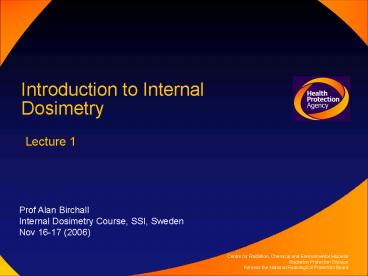Introduction to Internal Dosimetry PowerPoint PPT Presentation
1 / 40
Title: Introduction to Internal Dosimetry
1
Introduction to Internal Dosimetry
Lecture 1
Prof Alan Birchall Internal Dosimetry Course,
SSI, Sweden Nov 16-17 (2006)
2
Introduction to Internal Dosimetry
Structure
1. Introduction
2. Definition of Quantities
3. Calculation of Quantities
4. Mathematical models
5. Summary
3
Introduction to Internal Dosimetry
Structure
1. Introduction
2. Definition of Quantities
3. Calculation of Quantities
4. Mathematical models
GI-tract model Bone model Respiratory Tract
Model Systemic models
5. Summary
4
1. Introduction
Radiological protection
Radiological Protection for internal emitters
follows the same general principles as for
external dosimetry...
1. Justification 2. Optimisation 3. Limitation
5
2. Definition of Quantities
Absorbed dose
The basic unit of dosimetry is absorbed dose,
defined as energy per unit mass
6
2. Definition of Quantities
Equivalent dose
Some types of radiation are more harmful than
others...
7
2. Definition of Quantities
Effective Dose
Some types of tissues are more sensitive than
others...
8
2. Definition of Quantities
Committed doses
Doses are not instantaneous, but spread out in
time..
Committed equivalent dose
Committed effective dose
T is usually taken to be 50 years
9
2. Definition of Quantities
Dose coefficient
A dose coefficient is defined as the effective
dose from 1 Bq intake, under standard ICRP
default conditions
Depends on radionuclide
route of intake.
10
3. Calculation of Quantities
Example
Suppose 1 million atoms of Pu-239 decay in the
liver. What is the committed effective dose?
1. Absorbed Dose
2. Equivalent Dose
3. Effective Dose
11
3. Calculation of Quantities
Problem
What happens if not all of the energy is
deposited?
1. Bone/lung dosimetry
2. GI tract dosimetry
3. photons
12
3. Calculation of Quantities
Solution
Absorbed Fractions
Target Organ
Source Organ
A Target organ will receive a dose from the
Source organ depending on its anatomical
proximity.
13
3. Calculation of Quantities
Generalised Solution
The absorbed dose in the target organ per
disintegration in the source organ is known as
the Specific Effective Energy, SEE
The net dose to the target (T) from the
disintegrations (Us) in the Source Organ (S) is
thus
14
3. Calculation of Quantities
Only 2 problems remain
Problem 1
How do we calculate AF or SEE?
Problem 2
How do we calculate Us?
15
3. Calculation of Quantities
How do we calculate AF
PROBLEM 1
Photons
Use a mathematical phantom AFs tabulated as a
function of energy
Alphas and Betas
AF(S?T) 1 (if S T) AF(S?T) 0 (if S ? T)
Exceptionsbone, gut, lung
Need a dosimetry model
16
3. Calculation of Quantities
How do we calculate Us
PROBLEM 2
We need to be able to calculate how many
disintegrations there are in each Source organ
Need a biokinetic model
17
4. Mathematical Models
4 main types
Identify source and targets
Biokinetic model (Us)
Dosimetric model
18
4. Mathematical Models
GI Tract Model
Source Organs(4)
Stomach
Small Intestine (SI)
Upper Large Intestine (ULI)
Lower Large Intestine (LLI)
Target Organs(1)
Epithelial cells in the mucosal layer
19
4. Mathematical Models
GI Tract Model (biokinetic)
20
4. Mathematical Models
GI Tract Model (biokinetic)
Target cells
The epithelial cells comprising the mucosal layer
of each section of the GI-tract. In practice,
the average dose to the walls of the tract is
used as a measure of the dose to the mucosal
layer.
Absorbed fractions
21
4. Mathematical Models
GI Tract Model (biokinetic)
22
4. Mathematical Models
Bone model
Source Organs(2)
Trabecular Bone
Cortical Bone
Target Organs(2)
Bone surfaces
Bone marrow
23
4. Mathematical Models
Bone Model (biokinetic)
ICRP 30 type models
24
4. Mathematical Models
Bone Model (biokinetic)
ICRP 56 type models
Cortical and trabecular compartments specified in
biokinetic model
25
4. Calculation of Quantities
Bone model (dosimetric)
Absorbed Fractions
26
4. Calculation of Quantities
Respiratory tract model
28482
27
4. Calculation of Quantities
Respiratory tract model
5 main regions
25475
28
4. Calculation of Quantities
Respiratory tract model (biokinetics)
Particle transport
29
4. Calculation of Quantities
Respiratory tract model (biokinetics)
Absorption
30
4. Calculation of Quantities
Respiratory tract model (biokinetics)
Particle transport
Absorption
31
4. Calculation of Quantities
Respiratory tract model (dosimetry)
Source regions
Target regions
BB
bb
32
4. Calculation of Quantities
Respiratory tract model (dosimetry)
However, these were rejected by the main
commission because of the possible enhanced
effects of smoking.
In the ICRP 66 model, each lung region (BB, bb,
AI) is treated separately, and so needs its own
weighting factors.
X
0.8
BB
X
bb
0.15
X
AI
0.05
33
4. Calculation of Quantities
Respiratory tract model (dosimetry)
The data was re-evaluated by the Task Group, and
new weights were suggested which took account of
smoking.
However, these were also rejected by the main
commission because of the lack of evidence
X
0.6
BB
X
bb
0.3
X
AI
0.1
34
4. Calculation of Quantities
Respiratory tract model (dosimetry)
The main commission eventually decided to use the
following default values
0.333
BB
bb
0.333
AI
0.333
35
4. Calculation of Quantities
Respiratory tract model (dosimetry)
Effective dose to extrathoracic region
Effective dose to thoracic region
36
4. Mathematical Models
Systemic models
Source Organs
Organs are both the source and target
Target Organs
37
4. Calculation of Quantities
Systemic model (biokinetics)
ICRP 30 type models
38
4. Calculation of Quantities
Systemic model (biokinetics)
ICRP 56 type models
To simplify calculations, in IMBA, organ
retention is represented by sums of exponential
terms
39
4. Calculation of Quantities
Systemic model (dosimetry)
For alphas and betas
AF 1 if source target
AF 0 if source ? target
For gammas
AF f(energy)
40
5. Summary
Dosimetry is very simple
THE END

